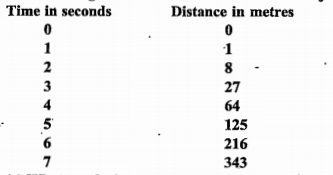The following is the distance time table of an object in motion

(a) What conclusion can you draw about the acceleration ? Is it constant increasing , decreasing or zero ?
(b) What do you infer about the forces acting on the object ? Solution in Kannada
There is an uneequal change of distance in an equal interval of time. Thus, the given object .
is having a non uniform motion since the velocity of the object increasing with time , the acceleration is increasing.
The object is in accelerated condition. According to Newton.s second law of motion, the force acting on an object is directly proportional to the acceleration produced in the object is directly proportional to the acceleration produced in the object , so we can say unbalanced force is acting on the object.
Topper's Solved these Questions
- FORCE AND LAWS OF MOTIONBook:CPC CAMBRIDGE PUBLICATIONChapter:FORCE AND LAWS OF MOTIONExercise:ADDITIONAL QUESTIONS
Explore 20 Videos
- FORCE AND LAWS OF MOTIONBook:CPC CAMBRIDGE PUBLICATIONChapter:FORCE AND LAWS OF MOTIONExercise:UNIT TEST
Explore 2 Videos
- FORCE AND LAWS OF MOTIONBook:CPC CAMBRIDGE PUBLICATIONChapter:FORCE AND LAWS OF MOTIONExercise:EXERCISE
Explore 18 Videos
- GRAVITATIONBook:CPC CAMBRIDGE PUBLICATIONChapter:GRAVITATIONExercise:ADDITIONAL QUESTIONS (MATCH THE FOLLOWING)
Explore 1 Video
Similar Questions
Define the SI unit of force.
View SolutionA truck starts from rest and rolls down a hill with constant acceleration . It travels a distance of 400 m in 20 s . Find its acceleration. Find the force acting on it if its mass is 7 metric tonners (Hint 1metric tone - 1000 kg)
View SolutionAn object experience a net zero exteranal unbalanced force. Is it possible for the object to be travelling with a non zero velocity ? If yes, state the condition that must be placed on the magnitude and direction of the velocity.
If no, provide reason.
View Solution(1)Force between the sum & moon(a)F=Gm1m2ld2sum and moon(2)Gravitational constant G(b)used to determine acceleration due to gravity(3)Simple pendulum(c)depends on masses(4)Newton's law of gravitation(d)Action at a distance(e)is universal
View SolutionWhat can you say about the motion of an object whose distance-time graph is a straight line parallel to the time axis ?
View SolutionThe following is the distance-time table of an object in motion:
Time in secondsDistance in metres001128327464512562167343
(a) What conclusion can you draw about the acceleration? Is it constant, increasing, decreasing, or zero?
(b) What do you infer about the forces acting on the object?
View Solutionएक वस्तु की गति कि अवस्था में दूर - समय सारणी निम्नवत है
समय (सेकण्ड)दुरी (मीटर )001128327465512562167343
(a) त्वरण के बारे में आप क्या निष्कर्ष निकाल सकते हैं ? क्या यह नियत है ? बढ़ रहा है ? घाट रहा है ? या शून्य है ?
(b) आप वस्तु पर लगने वाले बल के बारे में क्या निष्कर्ष निकाल सकते हैं ?
View Solutionएक वस्तु की गति की अवस्था में दूरी समय सारणी निम्नवत है

a. त्वरण के बारे में आप क्या निष्कर्ष निकाल सकते हैं? क्या यह नियत है? बढ़ रहा है? घट रहा है? या शून्य है?
b. आप वस्तु पर लगने वाले बल के बारे में क्या निष्कर्ष निकाल सकते हैं?
View SolutionThe second-time array in the state of motion of an object is as follows: What can you conclude about acceleration? Is it due Growing up? Or zero?
View SolutionThe second-time array in the state of motion of an object is as follows: What can you conclude about the force exerted on the object?
View SolutionThe following is the distance-time table of an object in motion: What conclusion can you draw about acceleration? Is it constant, increasing deacreasing or zero?

View SolutionThe following is the distance-time table of an object in motion: What do you infer about forces acting on object?
View SolutionThe following is the distance-time table of an object in motion:

What conclusion can you draw about the acceleration? Is ti constant, increasing, decreasing, or zero?
View SolutionThe following is the distance-time table of an object in motion:

What do you infer about the forces acting on the object?
View SolutionThe following is the distance-time table of an object in motion: (a)What conclusion can you draw about the acceleration ?Is it constant. Increasing decreasing ir zero? (b)What do you infer about the force acting on the object?
View Solution